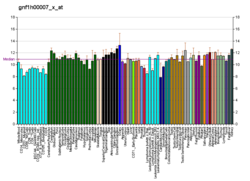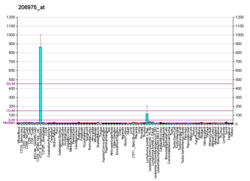Lymphotoxin-alpha (LT-α) formerly known as tumor necrosis factor-beta (TNF-β)[5][6] is a protein that in humans is encoded by the LTA gene.[7][8] Belonging to the hematopoietic cell line, LT-α exhibits anti-proliferative activity and causes the cellular destruction of tumor cell lines.[7] As a cytotoxic protein, LT-α performs a variety of important roles in immune regulation depending on the form that it is secreted as. Unlike other members of the TNF superfamily, LT-α is only found as a soluble homotrimer, when found at the cell surface it is found only as a heterotrimer with LTβ.[6]
LT-α has a significant impact on the maintenance of the immune system including the development of secondary lymphoid organs.[9][10] Absence of LT-α leads to the disruption of gastrointestinal development, prevents Peyer's patch development, and results in a disorganized spleen.[11]
As a signaling molecule, LT-α is involved in the regulation of cell survival, proliferation, differentiation, and apoptosis.[12] LT-α plays an important role in innate immune regulation and its presence has been shown to prevent tumor growth and destroy cancerous cell lines.[13] In contrast, unregulated expression of LT-α can result in a constantly active signaling pathway, thus leading to uncontrolled cellular growth and creation of tumors.[12] Hence depending on the context, LT-α may function to prevent growth of cancer cells or facilitate the development of tumors. Furthermore, LT-α effects depend on the type of organ it acts upon, type of cancer cells, cellular environment, gender, and time of effect during an immune response.[14][13]
- ^ a b c ENSG00000223919, ENSG00000173503, ENSG00000226275, ENSG00000230279, ENSG00000238130, ENSG00000226979 GRCh38: Ensembl release 89: ENSG00000231408, ENSG00000223919, ENSG00000173503, ENSG00000226275, ENSG00000230279, ENSG00000238130, ENSG00000226979 – Ensembl, May 2017
- ^ a b c GRCm38: Ensembl release 89: ENSMUSG00000024402 – Ensembl, May 2017
- ^ "Human PubMed Reference:". National Center for Biotechnology Information, U.S. National Library of Medicine.
- ^ "Mouse PubMed Reference:". National Center for Biotechnology Information, U.S. National Library of Medicine.
- ^ "Lymphotoxin Alpha - an overview | ScienceDirect Topics".
- ^ a b Calmon-Hamaty, Flavia; Combe, Bernard; Hahne, Michael; Morel, Jacques (2011). "Lymphotoxin α revisited: general features and implications in rheumatoid arthritis". Arthritis Research & Therapy. 13 (4): 232. doi:10.1186/ar3376. PMC 3239340. PMID 21861866.
- ^ a b Nedwin GE, Naylor SL, Sakaguchi AY, Smith D, Jarrett-Nedwin J, Pennica D, Goeddel DV, Gray PW (September 1985). "Human lymphotoxin and tumor necrosis factor genes: structure, homology and chromosomal localization". Nucleic Acids Research. 13 (17): 6361–73. doi:10.1093/nar/13.17.6361. PMC 321958. PMID 2995927.
- ^ Aggarwal BB, Eessalu TE, Hass PE (February 1986). "Characterization of receptors for human tumour necrosis factor and their regulation by gamma-interferon". Nature. 318 (6047): 665–7. doi:10.1038/318665a0. PMID 3001529. S2CID 4341571.
- ^ Ruddle NH (April 2014). "Lymphotoxin and TNF: how it all began-a tribute to the travelers". Cytokine & Growth Factor Reviews. 25 (2): 83–9. doi:10.1016/j.cytogfr.2014.02.001. PMC 4027955. PMID 24636534.
- ^ Cite error: The named reference
Ngo_1999was invoked but never defined (see the help page). - ^ Gubernatorova EO, Tumanov AV (November 2016). "Tumor Necrosis Factor and Lymphotoxin in Regulation of Intestinal Inflammation". Biochemistry. Biokhimiia. 81 (11): 1309–1325. doi:10.1134/S0006297916110092. PMID 27914457. S2CID 15764230.
- ^ a b Bauer J, Namineni S, Reisinger F, Zöller J, Yuan D, Heikenwälder M (2012-01-01). "Lymphotoxin, NF-ĸB, and cancer: the dark side of cytokines". Digestive Diseases. 30 (5): 453–68. doi:10.1159/000341690. PMID 23108301. S2CID 13165828.
- ^ a b Fernandes MT, Dejardin E, dos Santos NR (April 2016). "Context-dependent roles for lymphotoxin-β receptor signaling in cancer development". Biochimica et Biophysica Acta (BBA) - Reviews on Cancer. 1865 (2): 204–19. doi:10.1016/j.bbcan.2016.02.005. hdl:10400.1/9527. PMID 26923876.
- ^ Wong GH, Kaspar RL, Zweiger G, Carlson C, Fong SE, Ehsani N, Vehar G (January 1996). "Strategies for manipulating apoptosis for cancer therapy with tumor necrosis factor and lymphotoxin". Journal of Cellular Biochemistry. 60 (1): 56–60. doi:10.1002/(SICI)1097-4644(19960101)60:1<56::AID-JCB9>3.0.CO;2-2. PMID 8825416. S2CID 42014048.






